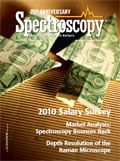Article
Spectroscopy
Spectroscopy
Defending the Food Chain
Author(s):
In the field of materials analysis, it is no secret that the topic of food safety is currently garnering more and more attention, with instrumentation from nearly every technique area being employed in the fight against contaminations and poisonings.
In the field of materials analysis, it is no secret that the topic of food safety is currently garnering more and more attention, with instrumentation from nearly every technique area being employed in the fight against contaminations and poisonings. FT-IR, ICP-MS, and IRMS (to name just a few techniques) have been featured in many recent columns and articles geared toward food safety in the pages of this journal and have been featured at conferences and symposia around the world as well.

David Walsh
However, at the recent IFPAC Conference, held last month in Baltimore, Maryland, an interesting shift in the food safety discussion could be sensed, as Dr. Glenn Black, Director of Science Operations of the Grocery Manufacturers Association, delivered an insightful talk as part of the opening plenary session. Dr. Black signaled that a new phase of the ongoing worldwide food safety battle may have been reached. "Food safety" was replaced by "food defense" as Dr. Black described the need to defend the food chain from start to finish, definitely a more aggressive posture with regard to preventing future contaminations and poisonings. After the dog food, baby food, and peanut butter scares of recent years, it is clear that the public's tolerance for food safety crises is becoming lower and lower, so this more aggressive stance is a wise one to say the least.
It will be interesting to see how this issue continues to unfold, and as always, be sure to look for more on this topic in future issues of Spectroscopy, where food safety continues to generate a great deal of research and commentary. Last month's feature on the validation of extra virgin olive oil and international food products in general generated a great deal of buzz, as the team of researchers from Ohio University focused on an issue of increasing importance, and additional food safety features are planned throughout 2010.
In the meantime, we hope you enjoy the issue.

David Walsh
Editor-in-Chief
Newsletter
Get essential updates on the latest spectroscopy technologies, regulatory standards, and best practices—subscribe today to Spectroscopy.


